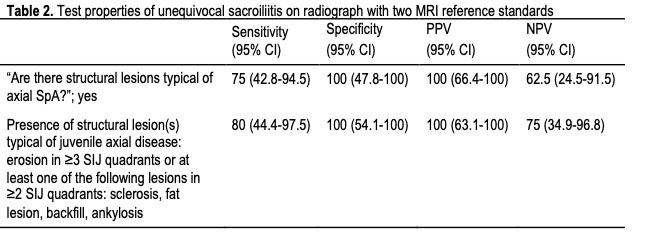Session Information
Session Type: Poster Session B
Session Time: 9:00AM-10:30AM
Background/Purpose: Radiographs are neither sensitive nor reliable in assessment of axial disease in juvenile spondyloarthritis (JSpA). However, they are still performed in some areas due to difficulty in accessing MRI. We aimed to define criteria for unequivocal evidence of sacroiliitis on pelvic radiography in skeletally immature youth for use in classification criteria.
Methods: Subjects were a retrospective cohort of JSpA and symptom onset prior to age 18 years. All subjects had an MRI as part of a diagnostic evaluation for axial disease; a subset of subjects also had a pelvic radiograph. Six musculoskeletal imaging experts, blinded to clinical details, reviewed the radiographs and graded them using the modified New York (mNY) criteria. Agreement was assessed using random effects intraclass correlation coefficient (ICC). Next, the imaging team underwent an iterative consensus process to define “unequivocal sacroiliitis” on radiography in skeletally immature youth. Radiographs with a non-zero mNY grade by ≥2 raters in ≥1 joint were reviewed for presence/absence of “unequivocal sacroiliitis”. Interrater agreement was assessed with Fleiss’ kappa statistic. The exercise was repeated 6 months later to assess intra-rater agreement. The performance of the novel definition was tested using 2 reference standards ascertained by MRI: 1) Global assessment of “Are there structural lesions typical of axial SpA?”, and 2) structural lesion definitions for MRI typical of juvenile axial disease (erosion in ≥3 sacroiliac joint SIJ) quadrants or ≥1 of the following lesions in ≥2 SIJ quadrants: sclerosis, fat lesion, backfill, ankylosis).
Results: Radiographs from 119 subjects, 61% male, median age 14.7 years, had an AP pelvic radiograph available for scoring. The frequency of radiographs meeting the mNY criteria are shown in Table 1. The ICC was fair among raters for joints with at least a non-zero grade in ≥1 joint (0.45, 95% CI: 0.34-0.57). “Unequivocal sacroiliitis” by radiograph in skeletally immature youth was defined as “Unequivocal lesion (erosion, sclerosis, or ankylosis [partial or complete]) that must include at least one iliac bone. When sclerosis is present in isolation, if measurable, should extend ≥5mm from the joint surface. The decision may be influenced by the presence of other lesions, which in themselves do not suffice to meet the criterion.” Examples of radiographs with “unequivocal sacroiliitis” are shown in Figure 1. Eighteen radiographs were assessed using the consensus definition (Table 1). Nine (50%) radiographs were rated as “unequivocal sacroiliitis” by a majority and Fleiss’ kappa was good at 0.61 (95% CI: 0.41-0.80). Intra-rater reliability ranged from 0.37 to 0.89, with 50% of raters achieving a kappa >0.8. The novel definition achieved 100% specificity using both MRI reference standards (Table 2).
Conclusion: We propose the first consensus-derived definition of unequivocal sacroiliitis by radiography in skeletally immature youth. This definition had better interrater reliability than the mNY and 100% specificity using two MRI reference standards. This definition has applicability to JSpA axial disease classification criteria when MRI is unavailable.
To cite this abstract in AMA style:
Weiss P, Brandon T, Lambert R, Biko D, Chauvin N, Francavilla M, Herregods N, Hendry A, Maksymowych W. Consensus-Driven Definition for Unequivocal Sacroiliitis on Radiographs for Classification in Juvenile Spondyloarthritis [abstract]. Arthritis Rheumatol. 2022; 74 (suppl 9). https://acrabstracts.org/abstract/consensus-driven-definition-for-unequivocal-sacroiliitis-on-radiographs-for-classification-in-juvenile-spondyloarthritis/. Accessed .« Back to ACR Convergence 2022
ACR Meeting Abstracts - https://acrabstracts.org/abstract/consensus-driven-definition-for-unequivocal-sacroiliitis-on-radiographs-for-classification-in-juvenile-spondyloarthritis/



